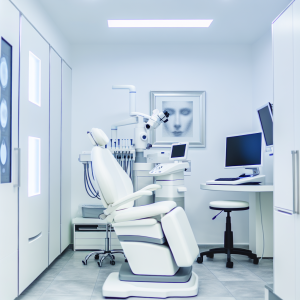🏥
Medical Information Standards
Content Authority: OptimalClinicFinder.com is a comprehensive medical directory platform connecting patients with qualified Botox providers. Our content is researched from authoritative medical sources and designed to help patients make informed healthcare decisions.
How Botox Works: Clinical Mechanism and Applications
Botox (onabotulinumtoxinA) belongs to a class of medications called neurotoxins, which work by temporarily blocking nerve signals that cause muscle contractions. When administered around the eyes, the medication binds to nerve terminals and prevents the release of acetylcholine, a neurotransmitter responsible for muscle movement. This targeted muscle relaxation reduces the formation of dynamic wrinkles and crow’s feet that develop from repetitive facial expressions.
The medication’s primary mechanism involves several key pathways: presynaptic blockade of acetylcholine release, temporary denervation of targeted muscles, and gradual restoration of normal function over 3-4 months. This precise approach addresses the muscular causes of periorbital aging while preserving natural facial expression when administered by skilled practitioners.
💡
Did You Know?
Clinical studies show that Botox patients achieve excellent results when combined with professional-grade aftercare products.
Clinical Research and Evidence Base
The clinical development of Botox for cosmetic applications involved multiple large-scale randomized controlled trials, including the landmark studies by Carruthers and Carruthers that established its efficacy for crow’s feet treatment. These trials enrolled over 833 participants across diverse demographics and followed patients for up to 6 months. The primary endpoint data consistently demonstrated significant improvements in wrinkle severity scores compared to placebo.
Subgroup analyses revealed that Botox effectiveness extends across different age groups, with particular efficacy in patients aged 30-65 years. The medication showed measurable improvement in both moderate and severe crow’s feet, with satisfaction rates exceeding 90% in clinical trials. Long-term studies have confirmed the safety of repeated treatments and sustained patient satisfaction over multiple treatment cycles.
Treatment Protocols and Clinical Management
Successful Botox treatment requires careful patient assessment and individualized injection planning. The initial evaluation process includes comprehensive facial analysis, muscle movement assessment, skin quality evaluation, and discussion of realistic expectations. Healthcare providers must assess facial anatomy, establish treatment goals, and develop comprehensive pre- and post-treatment care protocols.
The standard treatment protocol involves precise injection placement using 30-32 gauge needles to minimize discomfort. Most patients receive 12-20 units per eye area, with injections placed at the lateral canthal area and extending toward the temple. The procedure typically takes 10-15 minutes, with most patients experiencing minimal discomfort. Post-treatment instructions include avoiding rubbing the treated area, remaining upright for 4 hours, and avoiding strenuous exercise for 24 hours.
💡
Quick Tip
Botox works best when combined with healthy lifestyle choices for optimal results.
Safety Profile and Risk Management
The safety profile of Botox for cosmetic applications has been extensively characterized through clinical trials and post-marketing surveillance involving millions of treatments. The most common adverse events include temporary bruising (10-15% of patients), mild injection site discomfort, and transient headache. These effects typically resolve within 24-48 hours and can be minimized through proper injection technique and post-treatment care.
Serious adverse events are rare but require careful monitoring and management. These include temporary eyelid ptosis (1-3% of patients), dry eye symptoms, and asymmetry. Risk factors for complications include improper injection placement, excessive dosing, and individual anatomical variations. Healthcare providers should educate patients about warning signs and establish clear protocols for follow-up care and complication management.
Cost Analysis and Access Considerations
The cost of Botox treatment varies significantly based on geographic location, provider experience, and treatment complexity. The average cost per unit ranges from $10-$25, with most under-eye treatments requiring 24-40 total units. Treatment costs are generally not covered by insurance as they are considered cosmetic procedures, though some patients may qualify for coverage when treating medical conditions like excessive sweating or migraines.
Many providers offer package deals for multiple treatment areas or membership programs that provide discounts for regular patients. Financing options through medical credit companies can help patients manage treatment costs. It’s important to prioritize provider qualifications and safety over cost considerations, as improper treatment can result in unsatisfactory results or complications requiring corrective procedures.
Provider Selection and Treatment Access
Choosing an experienced healthcare provider is crucial for optimal Botox treatment outcomes. Patients should seek providers with specific expertise in facial anatomy and extensive experience with cosmetic injectables. Board certification in dermatology, plastic surgery, or other relevant specialties, along with specialized training in aesthetic procedures, are important selection criteria.
⚠️
Safety First
Always consult a qualified medical professional before starting Botox. Results vary by individual.
✓
Why Choose Botox?
●
Clinically proven
●
FDA approved
●
Minimal downtime
●
Long-lasting
Access to qualified Botox providers has expanded significantly as the treatment has become more mainstream. Many dermatology practices, plastic surgery centers, and medical spas now offer these services. Patients should research potential providers thoroughly, review before-and-after photos, read patient testimonials, and schedule consultations to assess comfort level and treatment approach before proceeding with treatment.
Botox Under Eyes: Advanced Techniques and Considerations
Modern botox under eyes treatments have evolved to incorporate advanced injection techniques that maximize results while minimizing risks. Skilled practitioners now use micro-droplet techniques, anatomical mapping, and customized dosing protocols to achieve natural-looking results. The periorbital area requires particular expertise due to the complex muscular anatomy and proximity to the eyelid margin.
Contemporary approaches to botox under eyes treatment consider the entire periorbital region, including the orbicularis oculi muscle, procerus, and corrugator muscles. This comprehensive approach addresses not only crow’s feet but also contributes to overall eye area rejuvenation. Advanced practitioners may combine Botox with other treatments like dermal fillers or skin resurfacing procedures for optimal aesthetic outcomes.
Results Timeline and Maintenance
Understanding the timeline of Botox results helps patients set appropriate expectations and plan for maintenance treatments. Initial effects typically become visible within 3-5 days, with progressive improvement over the first two weeks. Peak results are generally achieved at 2-3 weeks post-treatment, with effects lasting 3-4 months for most patients.
Maintenance treatment timing varies among individuals but typically occurs every 3-4 months for optimal results. Some patients may experience longer-lasting effects with repeated treatments as targeted muscles become trained to relax. Regular maintenance appointments also allow providers to assess results, adjust techniques, and address any concerns that may arise during the treatment process.
📚 Medical Authorities & Professional Standards
All Botox procedures should be performed by licensed medical professionals following established clinical guidelines and safety protocols.
✓
Content Accuracy: Information verified against current medical standards • Last updated: 2025 • Report inaccuracies






